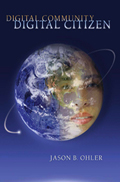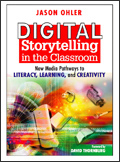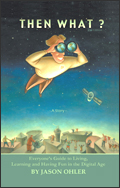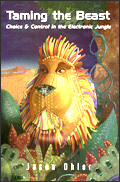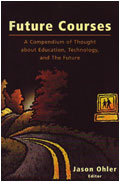 The book begins with "Twenty Revelations about Digital Storytelling in Education." We are up to revelation 15. You are invited to visit previous journal entries to read the first fourteen.
The book begins with "Twenty Revelations about Digital Storytelling in Education." We are up to revelation 15. You are invited to visit previous journal entries to read the first fourteen.Revelation #15: Digital stories allow digital natives to pursue academic content in their own language.
Book excerpt: "Students inhabit a largely oral and digital world, then sit in classrooms where the printed word is the primary medium in play. Digital storytelling allows students to express content-area understanding in ways that are familiar. I have seen digital stories that do everything from explain math, science, and literature concepts to illuminate the interior landscapes of cultural, artistic, and personal perspective."
----------------
 A real road sign
A real road signA picture taken by photographer Clay Good somewhere in the Catskills. It should appear at every on-ramp to the information highway.
Click on the photo to enlarge.
---------
The social networks in 1990 – forward to the past
The online environment has always been a social network to me, even before the Internet became a household word. I was emailing, maintaining BITNET listservs and using USENET in the early 80s. (Those of you under 40 will need to ask an AARP member about this).
In 1990, I began a multi-year virtual community study of an in-house computer conferencing system called PortaCom. The study turned out to be my dissertation.
1990 was pre-web:
- nothing to click on
- everything in text
- mainframe dial-in access only
- terse error messages
- expand social networks… meet new people, make new friends, connect with others they could not otherwise
- engage in behaviors that they could not in RL… including the good (talking to people more honestly more often), the bad (cussing people out in virtual public), and the ugly (being rude just because and otherwise getting in touch with the adolescent within)
- build mutually beneficial communities… to do things like teach classes, buy and sell things, plan events, work on joint projects, help find and exchange resources, achieve critical mass surrounding issues by forming e-coalitions
social networking neologism
interlational - a neologism (a new word) that emerged from my online community study, meaning "across social boundaries."
Usage: "This act of interlational communication was facilitated by a lack of social cues within the computer conference."
Back story: One day I was observing a group of high school students and their teacher who were sitting in the same room while communicating within a computer conference. Face-to-face, I heard a student address his teacher as "Mr. Smith," while within the computer conference he called his teacher by his first name. The lack of social cues encouraged the student to cross "social lata" and address his teacher more familiarly.
----------------
 New literacy: media collage. The shift from text centrism to media collage captured in a slide.
New literacy: media collage. The shift from text centrism to media collage captured in a slide.View entire "Beyond Words" presentation, from which this slide was taken.
Click on slide to enlarge.
----------------
TECHST MESSAGES... news bits from the tEcosystem...

Quotables
"I link therefore I am."
Discover more quotables.
--- -- ---
More neologisms
Besides interlational (see above):
- smob: smart + mob = smob. Isn't "smart mob" an oxymoron?
- dumbius: see below.
Usage: "Bobbi's sure a genius when it comes to understanding the theory of relativity, but what a dumbius when it comes to making rude noises at a social gathering."
What's a smart mob? According to Howard Rheingold (one of my favorite chroniclers of things digital), smart mob refers to a group demonstration or collective action fueled by information and communication technologies. As it is often used, it implies a spontaneous gathering facilitated by hand-held technology, though this is probably more accurately referred to as a "flash mob." Given that mobs are rarely planned, either can do. Purists may want to combine them to create another neologism, "flart mob," given that "smash mob" has so many unpleasant implications.
smob in wide use. Smob is the name of a band, a programming term, even an acronym for such worldly things as "student member of the board," and "Swiss Study Group for Morbid Obesity." And dumbius appears to be someone's screen name. So, use both with care.
--- -- ---
Free Tutorial: ISTE Teacher Standard VI, via SlideShare.net.
ISTE = International Society for Technology in Education.
ISTE Teacher Standard VI addresses the legal, ethical and human issues surrounding the uses of technology in education.
ISTE is the flagship organization for developing technology standards for K-12 education. Within its standards for teachers, students and administrators are standards that address the social impacts of technology. This tutorial addresses standards in this area for all three groups, while focusing on the standards for teachers.
--- -- ---
Inter-avi communication
 Imagine not being able to exchange email with someone because you use Thunderbird and she uses Outlook. Or not being able to see a web page because it was only written for Firefox.
Imagine not being able to exchange email with someone because you use Thunderbird and she uses Outlook. Or not being able to see a web page because it was only written for Firefox.That is where the virtual galaxy is now. Currently there is no straightforward way for avi's from, e.g., Second Life and World of War Craft, to talk to each other or exchange information.
But that could change. Read all about it.
Think of it as cross-cultural communication in the virtual domain. Or as a serious step toward The Matrix. Techies call it "interoperability."
--- -- ---
Report I am reading: Online Nation by the Sloan Consortium.
Sloan has done it again. This is a great report that provides a 2006 snapshot of the state of online learning in higher education in the U.S.
Interesting findings:
- During the last 5 years, online learning has grown 9.7%, compared with just 1.8% growth in overall student population.
- Nearly 20% of all higher ed students in 2006 were taking an online course.
Sleep walking art?
You mean, art that someone creates while sleeping?
Yes. Read all about it.

